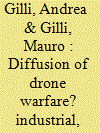|
|
|
Sort Order |
|
|
|
Items / Page
|
|
|
|
|
|
|
| Srl | Item |
| 1 |
ID:
147903


|
|
|
|
|
| Summary/Abstract |
Many scholars and policymakers are concerned that the emergence of drone warfare—a first step toward the robotics age—will promote instability and conflict at the international level. This view depends on the widely shared assumption among International Relations scholars that military hardware spreads easily, especially in the age of globalization and real-time communications. In this article, we question this consensus. Drawing from the literature in management, we advance a new theory of diffusion of military innovations and test its two underlying causal mechanisms. First, we argue that designing, developing, and manufacturing advanced weapon systems require laboratories, and testing and production facilities, as well as know-how and experience that cannot be easily borrowed from other fields. Second, we argue that the adoption of military innovations requires both organizational and infrastructural support. We test our two claims on three types of combat-effective drones: loitering attack munitions (LAMs), intelligence surveillance and reconnaissance drones (ISR), and unmanned combat autonomous vehicles (UCAVs). We find that even wealthy, advanced, and militarily capable countries such as the United States, the United Kingdom, Germany, and France have struggled to produce or adopt such platforms. We conclude that concerns about the diffusion of drone warfare appear significantly exaggerated, as do claims that globalization redistributes military power at the global level. More generally, our analysis sheds light on how the interaction between platform and adoption challenges affects the rate and speed of diffusion of different military innovations.
|
|
|
|
|
|
|
|
|
|
|
|
|
|
|
|
| 2 |
ID:
140402


|
|
|
|
|
| Summary/Abstract |
This article proposes a new theory of false optimism as a cause of war. Named for its similarity to the winner's curse in auctions, this theory explains how and why established sources of misperception (cognitive, psychological, bureaucratic, and organizational) interact with the selection of one military strategy from a set of alternatives to produce a surprising amount of additional false optimism. Even if a state's general perceptions of how well it will fare in a potential war are not biased toward optimism, this theory explains why its perceptions of the particular strategy on which it will base its plans for fighting that war will be systematically biased toward optimism. Simulations and formal modeling confirm the logic of the theory and suggest that the strategist's curse can sharply increase the probability of war due to false optimism.
|
|
|
|
|
|
|
|
|
|
|
|
|
|
|
|
| 3 |
ID:
112858


|
|
|
|
|
| Publication |
2012.
|
| Summary/Abstract |
Why do political organizations split? Drawing insight from organizational theory and social movement literature, this article explores the effect of organizational factors on group schism. Using a new data set of 112 ethnopolitical organizations in the Middle East, the article examines to what extent organizational factors such as leadership structure, organizational legality, and tactical intensity, as well as contextual variables such as state violence and external support for the organization, influence group schism. Findings show that organizations with a factional or competing leadership structure and those that use violence as a tactic are at a greater risk to split. Contrary to research on political parties, which highlight the importance of factional leadership structure in relation to the maintenance and growth of the party organization, findings suggest that competing leadership structure, along with the employment of tactical violence, precipitates ethnopolitical organizational fission and eventual splintering.
|
|
|
|
|
|
|
|
|
|
|
|
|
|
|
|
|
|
|
|
|